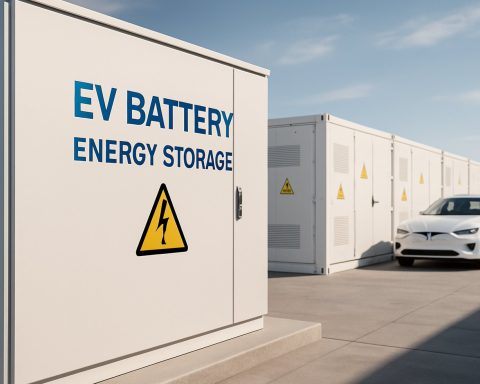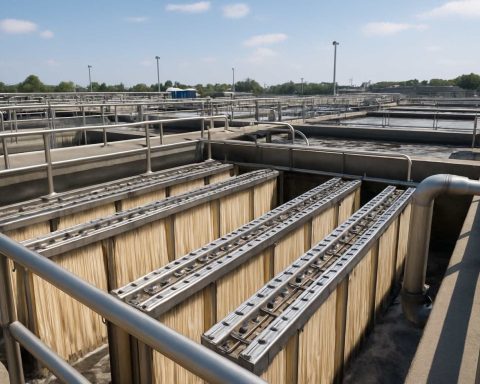- Japan’s energy companies, including Electric Power Development Co. and Osaka Gas Co., showcase synthetic fuels like e-methane and syngas at the Osaka World Expo.
- E-methane is seen as a potential carbon-neutral solution compatible with existing natural gas systems.
- Skepticism arises among environmentalists regarding continued reliance on fossil-fuel-based innovations.
- Japan aims for e-methane to comprise 1% of household gas by 2030, with a goal of 90% by 2050 amid economic challenges.
- The nation faces difficulties in large-scale renewable energy projects due to geographic and safety concerns.
- Japan’s energy future hinges on balancing synthetic innovations with a push towards fully renewable energy sources.
- Electric Power Development Co. plans syngas integration at Matsushima coal plant by 2028, despite storage uncertainties.
- The country stands at a pivotal moment, tasked with blending innovation and sustainability to secure a green future.
Picture this: a sprawling exhibition hall in Osaka, buzzing with excitement, where mascots cheerfully stroll past immersive virtual reality displays. The air is laced with the aroma of innovation. Here, Japan’s energy titans, like Electric Power Development Co. and Osaka Gas Co., are making waves with synthetic fuels like “e-methane” and “syngas” at the World Expo. But as these companies lay out a bold vision for Japan’s energy future, dividing opinions ripple through the crowd.
Amid the glimmering showcases, these companies present a strategic evolution, aiming to breathe new life into the existing tapestry of fossil-fuel infrastructure. The focal point is e-methane, lauded by experts for its seamless compatibility with current natural gas systems. By harnessing carbon dioxide, intricately merged with green hydrogen derived from renewable sources, this methane emerges as a beacon of carbon-neutral potential.
Yet, a sense of skepticism persists among environmental advocates. They argue that Japan’s steadfast commitments to fossil fuels make it a laggard among the G7 nations, and remind us of the environmental urgency at hand. The crux of their argument? These novel fuels do little more than delay the inevitable emissions unless robust carbon capture systems are fully integrated. They view the continued reliance on hybrid measures as barriers to an unbridled push toward renewables.
Japan’s intricate geographies present a challenging canvas for large-scale solar or wind energy projects. Moreover, nuclear energy’s renaissance grapples with deep-seated safety concerns post-Fukushima. As Sumiko Takeuchi, a respected voice in energy policy, points out, enhancing current plants with alternative fuels offers a path to decarbonization while safeguarding energy security.
Japan’s ambitions are clear: by 2030, companies like Osaka Gas and Tokyo Gas aim for e-methane to constitute a small yet meaningful 1% of household gas supplies. With sights set on an ambitious 90% substitution by 2050, the journey promises to be both arduous and transformative.
But formidable challenges loom, none more pressing than the economic ones. The costs of hybrid fuels currently double conventional power plant revenues. JERA Co.’s experiment with ammonia hints at future prospects but underscores the fiscal tightrope on which these ventures balance.
At the heart of this discourse is whether Japan will persist in weaving these synthetic threads or embrace a radical pivot to wholly renewable fabrics. Critics like Michiyo Miyamoto caution that the latter scenario, while fraught with risk, may herald a fully green future, unencumbered by the shadows of yesteryears.
Amidst the deliberations, the stakes rise with Electric Power Development Co.’s plan to weave syngas into its Matsushima coal plant’s operations by 2028. The promise is tantalizing: extracting hydrogen from coal-derived syngas for power generation. Yet, subterranean carbon storage remains fraught with technical and social uncertainties.
In essence, Japan’s energy odyssey is at a crossroads. The key takeaway from this energetic confluence of tradition and transformation? Bold innovation must harmonize with unwavering commitment to sustainability if it is to quell the voices of doubt and illuminate a greener pathway. Amid grand ambitions, Japan stands poised to redefine its legacy on the world’s energy stage.
Japan’s Energy Evolution: Will Synthetic Fuels Light the Way?
Introduction
Japan’s World Expo in Osaka showcases a vibrant tableau of the nation’s strategic energy innovations. Major players like Electric Power Development Co. and Osaka Gas Co. introduce synthetic fuels such as “e-methane” and “syngas,” promoting a forward-thinking vision for energy sustainability. Yet, these advancements spark a debate over the environmental future as stakeholders weigh their potential and pitfalls.
What are E-Methane and Syngas?
– E-Methane: This synthetic fuel mimics natural methane but promises reduced carbon footprints. It is produced by synthesizing carbon dioxide with green hydrogen sourced from renewable energy, aiming for compatibility with existing natural gas systems.
– Syngas (Synthesis Gas): Comprising hydrogen, carbon monoxide, and other gases, syngas is often derived from coal, biomass, or natural gas. Its versatility allows for use in generating electricity or producing synthetic natural gas and hydrogen.
Benefits of Synthetic Fuels
1. Infrastructure Compatibility: E-methane’s seamless compatibility with current natural gas systems offers an immediate advantage, as it can be transported and used without extensive modifications.
2. Carbon Neutral Potential: By capturing CO2, these synthetic fuels claim a carbon-neutral status, potentially balancing emissions when paired with effective carbon capture technologies.
3. Energy Security: For Japan, where geographical constraints hinder large-scale renewables, synthetic fuels address energy security, bridging the gap until renewables can be more fully adopted.
Real-World Use and Industry Trends
– Short-Term Goals: By 2030, companies like Osaka Gas aim for e-methane to make up 1% of household gas supplies. This incremental shift sets the stage for broader adoption.
– Long-Term Vision: The ambitious target of replacing 90% of traditional gas with e-methane by 2050 highlights a significant shift towards sustainability.
Economic Considerations
– Cost Barriers: Currently, the production of hybrid fuels like e-methane doubles the cost of conventional power generation. This presents a significant hurdle to scaling up its use.
– Investment in Carbon Capture: Fully realizing the benefits of synthetic fuels hinges on advances and investments in carbon capture and storage (CCS) technologies, which remain complex and costly.
Controversies and Limitations
– Environmental Concerns: Critics suggest that reliance on synthetic fuels may delay the transition away from fossil-fuel dependency. They argue that without robust CCS, these fuels won’t adequately curb emissions.
– Technical Challenges: Integrating syngas into coal plants is promising yet fraught with technological and social uncertainties, particularly around underground carbon storage.
Future Predictions and Market Forecasts
– Energy Transition: Analysts predict a gradual pivot towards synthetic fuels as a transitional strategy before Japan can fully embrace renewable sources.
– Technological Innovation: Continued R&D in CCS and fuel synthesis is crucial for overcoming current limitations and ultimately reducing costs.
Actionable Recommendations
1. Invest in CCS Innovation: Governments and corporations should prioritize CCS technology investments to realize synthetic fuels’ full potential.
2. Boost Renewable Energy Efforts: Continue to explore complementarities between synthetic fuels and renewables to gradually phase out reliance on fossil fuels.
3. Policy and Incentives: Implement policies that encourage the adoption of greener technologies and reduce financial barriers to entry for synthetic fuels.
Conclusion
Japan stands at an energy crossroads, with synthetic fuels offering a potential pathway to a sustainable future. However, the journey demands substantial innovation, steadfast commitment to cutting-edge technologies, and a strategic balance between existing infrastructure and new, renewable ventures.
For more information on innovative energy solutions, visit Osaka Gas, a pioneer in advancing these efforts within the Japanese market.











